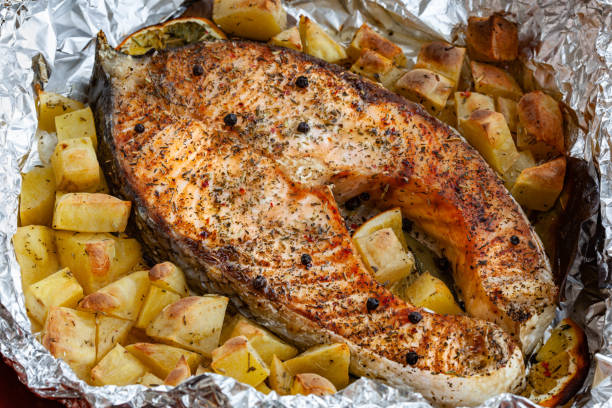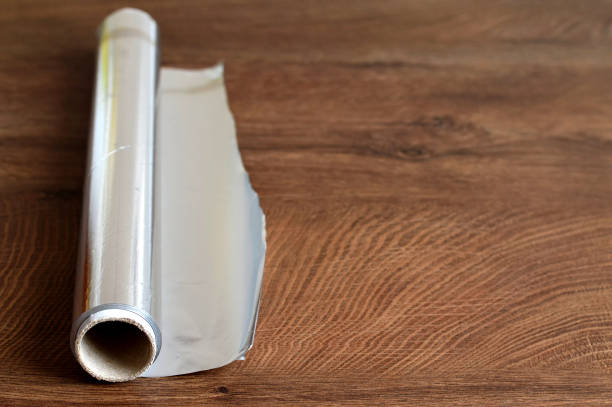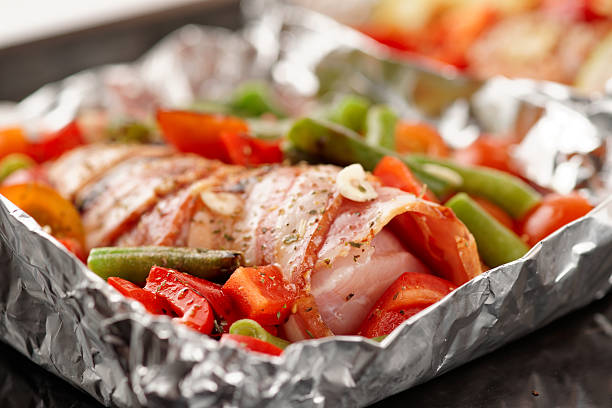In the sizzling realm of culinary curiosities, where kitchen myths and cooking conundrums swirl like aromatic spices, one question emerges as a shining foil-covered enigma: Is it safe to put aluminum foil in a frying pan?
As we embark on this culinary exploration, we peel back the layers of speculation to uncover the truth behind this shimmering kitchen controversy.
Brace yourself for a journey through the sizzle, snap, and pop of both conventional wisdom and culinary rebels, as we delve into the sparkling debate that has home chefs questioning whether to foil or not to foil their frying pan adventures.

Is It Safe To Put Aluminum Foil In Frying Pan
Yes, it is generally safe to use aluminum foil in a frying pan, but with some precautions.
When it comes to cooking, people often wonder about the safety of using aluminum foil in their frying pans. The kitchen is a hub of various cooking methods, and the use of aluminum foil has become a common practice.
However, before you line your frying pan with this versatile material, it’s essential to understand the potential risks and benefits associated with it.
Understanding Safety Precautions
Aluminum foil is known for its excellent heat-conducting properties, making it a popular choice for wrapping, storing, and even cooking food. When using it in a frying pan, ensure that it doesn’t touch open flames or extremely high heat.
Excessive heat can cause the foil to melt or leach into the food. To prevent this, it’s advisable to use aluminum foil as a lining rather than directly exposing it to the heat source.
Common Concerns and Misconceptions
People often express concerns about the safety of cooking with aluminum foil, fearing that it may release harmful substances into their food.
However, scientific studies suggest that under normal cooking conditions, the risk of aluminum leaching is minimal. To err on the side of caution, it’s wise to avoid using aluminum foil with acidic or salty foods, as these can accelerate the leaching process.
Benefits of Using Aluminum Foil in a Frying Pan
Apart from its heat-conducting properties, aluminum foil offers additional benefits in a frying pan. It acts as a barrier, preventing direct contact between the food and the pan, reducing the risk of sticking.
This can be especially useful when cooking delicate items like fish or preventing the need for excessive oil.
Properties of Aluminum Foil
Composition and Characteristics of Aluminum Foil
Aluminum foil is a versatile and indispensable material with a composition primarily made of aluminum, which is a lightweight and malleable metal.
The foil is typically produced by rolling heated aluminum ingots between large rollers, resulting in thin sheets. These sheets possess unique properties, such as being non-toxic, odorless, and resistant to moisture and light.
Aluminum foil exhibits excellent barrier properties, preventing the penetration of air and microorganisms. Its ability to reflect heat makes it ideal for various applications, from preserving food to insulating surfaces. Moreover, the foil is highly recyclable, aligning with eco-friendly practices.
Heat Conductivity of Aluminum Foil
One of the standout features of aluminum foil is its exceptional heat conductivity. With the ability to distribute and transfer heat quickly and evenly, aluminum foil proves itself as an efficient tool in the kitchen.
When wrapped around food items, it promotes uniform cooking and helps retain moisture, enhancing the flavors of the dishes.
The foil’s heat conductivity extends beyond culinary applications. It is commonly used in insulation materials and HVAC systems, showcasing its versatility in managing temperature-related challenges.
Common Uses of Aluminum Foil in the Kitchen
In the culinary realm, aluminum foil is a kitchen essential with a myriad of applications. Its pliability makes it easy to mold around various shapes, making it perfect for wrapping and covering food.
Grilling or baking with aluminum foil creates a protective barrier, preventing food from drying out while allowing for even cooking.
Aluminum foil acts as a reliable partner in preserving freshness. From covering leftovers to wrapping sandwiches, its impermeable nature helps maintain flavors and prevents cross-contamination.
Additionally, the foil proves invaluable for creating makeshift cooking vessels, such as foil packets for vegetables or fish, simplifying the cooking process.
Potential Risks of Using Aluminum Foil in Frying Pans
Chemical Reactions with Acidic or Salty Foods
1. Explanation of How Aluminum Can Leach into Food
While aluminum foil is generally considered safe for cooking, caution is advised when using it with acidic or salty foods. When exposed to such ingredients, a chemical reaction can occur, causing the aluminum to leach into the food.
This is particularly relevant when cooking dishes like tomatoes, citrus fruits, or those seasoned heavily with salt. The acidic or salty nature of the food can accelerate the breakdown of the protective oxide layer on the aluminum foil, leading to potential migration of aluminum into the meal.
2. Health Concerns Related to Aluminum Consumption
Excessive intake of aluminum has been associated with health concerns, including links to neurological disorders. While the amounts leached from aluminum foil during cooking are generally minimal, prolonged exposure or frequent consumption of aluminum-contaminated food may pose risks.
It’s advisable to exercise moderation and consider alternative cookware for dishes with high acidity or salt content.
High Temperatures and Melting Point of Aluminum
1. Discussion on the Risk of Melting Aluminum Foil in Frying Pans
Aluminum foil has a relatively low melting point compared to other cooking materials. While it does not melt easily in typical cooking scenarios, frying pans can reach high temperatures, especially during intense cooking or if left empty on high heat.
When the foil reaches its melting point, it can lose its structural integrity, potentially leading to the release of aluminum particles into the food.
2. Potential Release of Harmful Substances When Aluminum Reaches High Temperatures
At elevated temperatures, aluminum can release harmful substances, and there are concerns about the impact on human health. While the melting of aluminum foil in frying pans is rare, it is crucial to be mindful of cooking practices.
Avoid using aluminum foil in situations where high temperatures are anticipated, as the potential release of harmful substances may pose risks over time.

Safety Guidelines for Using Aluminum Foil in Frying Pans
Recommended Types of Food for Aluminum Foil Use
When using aluminum foil in frying pans, it is advisable to choose foods that are not overly acidic or salty. Opt for dishes like vegetables, meats, and poultry, which have a neutral pH and are less likely to trigger chemical reactions with the foil.
Additionally, aluminum foil is excellent for wrapping and cooking foods that benefit from even heat distribution, such as fish fillets or delicate vegetables.
Temperature Limits and Precautions
1. Safe Temperature Range for Using Aluminum Foil in Frying Pans
It is generally safe to use aluminum foil in frying pans at moderate temperatures. Stick to temperatures below 450°F (232°C) for safe and effective cooking without risking the foil’s integrity. This temperature range ensures that the foil remains stable and minimizes the potential for chemical reactions or melting.
2. Precautions to Prevent Overheating and Melting
To prevent overheating and melting of aluminum foil in frying pans, avoid using it on extremely high heat settings. Always check the manufacturer’s recommendations for both the frying pan and the aluminum foil.
If cooking at high temperatures is necessary, consider using alternative cookware or employing a layer of parchment paper between the food and the foil to add an extra barrier.
Proper Wrapping Techniques to Minimize Direct Contact with Food
When using aluminum foil, employ proper wrapping techniques to minimize direct contact between the foil and the food. Create a secure, but not overly tight, seal around the ingredients to prevent the foil from tearing during cooking.
This ensures that even if there is contact with acidic or salty juices, it’s contained within the foil. Additionally, consider leaving some space between the food and the foil to allow for heat circulation and prevent the risk of overheating.
Alternatives to Aluminum Foil in Frying Pans
Overview of Alternative Materials for Cooking
Numerous alternatives to aluminum foil exist for cooking in frying pans, each with its unique characteristics. Common substitutes include:
- Stainless Steel: Known for its durability and resistance to corrosion, stainless steel is a popular choice for frying pans. It provides even heat distribution and is less likely to react with acidic or salty foods.
- Cast Iron: Renowned for its excellent heat retention, cast iron pans are a favorite among chefs. They require seasoning to maintain their non-stick properties and are suitable for a variety of cooking styles.
- Ceramic: Ceramic-coated pans offer a non-stick surface without the concerns associated with traditional non-stick coatings. They are versatile and easy to clean.
- Glass: Glass pans are oven-safe and do not react with food. However, they may not be suitable for all stovetops.
Comparative Analysis of Safety and Performance
- Stainless Steel: Stainless steel is generally considered safe for cooking, offering durability and resistance to corrosion. However, it may require additional oil or fats to prevent sticking.
- Cast Iron: Cast iron pans are safe for cooking, providing excellent heat distribution. They require proper seasoning to maintain their non-stick surface and can be heavier compared to other materials.
- Ceramic: Ceramic-coated pans offer a safe non-stick option without the concerns associated with traditional non-stick coatings. They may require gentle care to avoid damage to the ceramic coating.
- Glass: Glass pans are safe for cooking and do not react with food. However, they may not be as versatile for stovetop use and can be prone to breakage.
Eco-Friendly Options for Conscious Consumers
For environmentally conscious consumers, exploring eco-friendly alternatives is essential. Consider the following:
- Cast Iron: Cast iron pans have a long lifespan and can be passed down through generations, reducing the need for frequent replacements.
- Stainless Steel: Stainless steel is highly durable and recyclable, making it an eco-friendly choice.
- Ceramic: Ceramic-coated pans with a responsibly manufactured coating can be a sustainable option, providing a non-stick surface without environmental concerns.
By opting for materials that align with safety, performance, and eco-friendly considerations, individuals can choose alternatives to aluminum foil that best suit their cooking preferences and values. Each material offers a unique set of benefits, allowing for a diverse range of choices in the kitchen.

Popular Myths and Facts about Aluminum Foil in Frying Pans
Addressing Common Misconceptions
1. Myth: Aluminum Foil Causes Alzheimer’s Disease
Fact: There is no conclusive scientific evidence linking the use of aluminum foil to Alzheimer’s disease. Aluminum exposure is primarily through food, and while excessive intake may pose health risks, current research does not support a direct connection to Alzheimer’s.
2. Myth: Cooking with Aluminum Foil Always Leads to Chemical Leaching
Fact: Aluminum foil is generally safe for cooking, but its reactivity with certain foods, especially acidic or salty ones, may lead to minimal aluminum leaching. However, this risk is significantly reduced when following proper cooking guidelines.
Providing Evidence-Based Information on the Safety of Aluminum Foil
1. Myth: Aluminum Foil Transfers Harmful Amounts of Metal to Food
Fact: Studies indicate that the amount of aluminum transferred to food during cooking is generally minimal. The World Health Organization considers daily aluminum intake from all sources to be safe for most individuals.
2. Myth: Using Aluminum Foil Increases the Risk of Cancer
Fact: There is no conclusive evidence that normal use of aluminum foil in cooking contributes to an increased risk of cancer. Aluminum is naturally present in the environment, and the body can efficiently eliminate it.
Separating Myths from Facts to Make Informed Decisions
1. Myth: Aluminum Foil Shouldn’t Be Used in High-Temperature Cooking
Fact: While aluminum foil has a lower melting point compared to some materials, it is safe for use in many cooking scenarios. It is important to adhere to recommended temperature limits and avoid extremely high heat settings to prevent potential issues.
2. Myth: Wrapping Acidic Foods in Aluminum Foil Is Always Unsafe
Fact: While it’s true that acidic or salty foods can lead to chemical reactions with aluminum, this risk can be mitigated by using proper cooking techniques. Adding a protective layer, such as parchment paper, can further reduce the chance of aluminum leaching.
Case Studies and Experiments on Aluminum Foil in Frying Pans
Examples of Real-World Scenarios Where Aluminum Foil Is Used in Frying Pans:
1. Grilling Fish in Aluminum Foil
Scenario: Many individuals use aluminum foil to wrap and grill fish in frying pans. The foil helps retain moisture, prevents sticking, and allows for even cooking. This practice is popular for its convenience and ability to enhance the flavors of the fish.
2. Baking Vegetables with Aluminum Foil
Scenario: Roasting vegetables in a frying pan with aluminum foil is a common practice. The foil creates a barrier that helps vegetables cook evenly, preserving their natural flavors. It also simplifies the cleanup process, making it a preferred method for home cooks.
Results of Experiments Testing the Safety and Efficacy of Aluminum Foil:
1. Heat Distribution Experiment
Results: Controlled experiments have demonstrated that aluminum foil contributes to even heat distribution when used in frying pans. This property makes it an effective tool for cooking various dishes, ensuring that food is cooked uniformly.
2. Acidic Food Interaction Study
Results: Experiments simulating cooking scenarios with acidic foods and aluminum foil indicate that while some minimal leaching may occur, it is within acceptable limits. The use of aluminum foil with proper wrapping techniques and precautions helps mitigate the potential risks associated with chemical reactions.
Insights Gained from Scientific Studies on Aluminum Foil in Cooking:
1. Migration Studies
Insights: Scientific studies have explored the migration of aluminum into food during cooking. While there is evidence of minimal transfer, researchers emphasize that the levels are generally well below the recommended daily intake. Proper cooking practices further reduce the potential for significant aluminum leaching.
2. Long-Term Exposure Assessments
Insights: Long-term exposure assessments indicate that, when used according to guidelines, aluminum foil in cooking is not associated with adverse health effects. The body efficiently eliminates absorbed aluminum, and the exposure from aluminum foil does not surpass established safety thresholds.

FAQs
Is it safe to use aluminum foil in a frying pan?
Absolutely! Aluminum foil can be safely used in a frying pan. It’s a versatile and convenient option that not only helps with easy cleanup but also distributes heat evenly for better cooking results.
Are there any health concerns associated with using aluminum foil in a frying pan?
No need to worry! When used as intended, aluminum foil poses no health risks in frying pans. It doesn’t leach harmful substances into your food, making it a safe and efficient choice for cooking.
Can aluminum foil be used for all types of frying pans, including non-stick ones?
Certainly! Aluminum foil is compatible with various types of frying pans, including non-stick surfaces. It acts as a protective barrier, preventing direct contact between the food and the pan while preserving the non-stick coating.
Does using aluminum foil affect the taste of the food when frying?
Not at all! Aluminum foil does not impart any taste to your food when used in a frying pan. Your meals will retain their delicious flavors, and you can enjoy the benefits of easy cooking and cleanup.
Are there any special precautions to take when using aluminum foil in a frying pan?
Using aluminum foil in a frying pan is generally safe, but it’s essential to avoid extremely high temperatures. Excessive heat can cause the foil to melt. Just ensure you’re within the recommended temperature range for your specific foil product.
Can I use aluminum foil in a frying pan on an induction cooktop?
Absolutely! Aluminum foil is induction-friendly and can be safely used in frying pans on induction cooktops. It doesn’t interfere with the cooking process and allows for efficient heat transfer.
How can I best utilize aluminum foil in a frying pan for cooking or baking?
Aluminum foil is a fantastic tool for both cooking and baking in a frying pan. It can be shaped to create packets for steaming, roasting, or even baking delicate items. Get creative and explore the various culinary possibilities it offers!
Conclusion
In conclusion, while using aluminum foil in a frying pan is generally considered safe for cooking, it is crucial to follow some essential guidelines to ensure a risk-free experience.
The potential concerns related to aluminum leaching into food can be mitigated by using high-quality, undamaged foil and avoiding acidic or salty foods.
Maintaining proper cooking temperatures and avoiding prolonged contact with aluminum can contribute to a safer cooking environment.
Ultimately, being informed about the potential risks and taking precautionary measures can help strike a balance between the convenience of using aluminum foil in a frying pan and ensuring the safety of the cooking process.